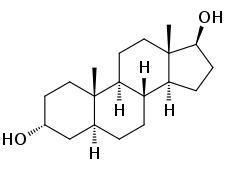3α-Androstanediol
3α-Androstanediol (often abbreviated as 3α-diol), also known as 5α-androstane-3α,17β-diol, is an endogenous inhibitory androstane neurosteroid and weak androgen, and a major metabolite of dihydrotestosterone (DHT).[1][2][3] As a neurosteroid, it acts as a potent positive allosteric modulator of the GABAA receptor,[4] and has been found to have rewarding,[5][6] anxiolytic,[7] pro-sexual,[8] and anticonvulsant effects.[9][10] As androgens such as testosterone and DHT are known to have many of the same effects as 3α-diol and are converted into it in vivo, it is thought that this compound may in part be responsible for said effects.[5][6][7][10] Relative to its isomer 3β-androstanediol, which is a potent estrogen, 3α-androstanediol has substantially lower, though still significant affinity for the estrogen receptors, with a several-fold preference for ERβ over ERα.[11][12] It has approximately 0.07% and 0.3% of the affinity of estradiol at the ERα and ERβ, respectively.[13]
 | |
| Names | |
|---|---|
| IUPAC name
(3R,5S,8R,9S,10S,13S,14S,17S)-10,13-Dimethyl-2,3,4,5,6,7,8,9,11,12,14,15,16,17-tetradecahydro-1H-cyclopenta[a]phenanthrene-3,17-diol | |
| Other names
Hombreol | |
| Identifiers | |
3D model (JSmol) |
|
| ChemSpider | |
| ECHA InfoCard | 100.015.862 |
PubChem CID |
|
| UNII | |
CompTox Dashboard (EPA) |
|
| |
| |
| Properties | |
| C19H32O2 | |
| Molar mass | 292.463 g·mol−1 |
Except where otherwise noted, data are given for materials in their standard state (at 25 °C [77 °F], 100 kPa). | |
| Infobox references | |
An orally active synthetic analogue of 3α-androstanediol, 17α-ethynyl-5α-androstane-3α,17β-diol (HE-3235, Apoptone), was formerly under investigation for the treatment of prostate cancer and breast cancer.[14]
Chemistry
See also
References
- Reddy DS (2010). Neurosteroids: endogenous role in the human brain and therapeutic potentials. Prog. Brain Res. Progress in Brain Research. 186. pp. 113–37. doi:10.1016/B978-0-444-53630-3.00008-7. ISBN 9780444536303. PMC 3139029. PMID 21094889.
- Jin Y, Penning TM (March 2001). "Steroid 5alpha-reductases and 3alpha-hydroxysteroid dehydrogenases: key enzymes in androgen metabolism". Best Pract. Res. Clin. Endocrinol. Metab. 15 (1): 79–94. doi:10.1053/beem.2001.0120. PMID 11469812.
- Penning TM, Bauman DR, Jin Y, Rizner TL (February 2007). "Identification of the molecular switch that regulates access of 5alpha-DHT to the androgen receptor". Mol. Cell. Endocrinol. 265-266: 77–82. doi:10.1016/j.mce.2006.12.007. PMC 1857325. PMID 17223255.
- Reddy DS, Jian K (September 2010). "The testosterone-derived neurosteroid androstanediol is a positive allosteric modulator of GABAA receptors". J. Pharmacol. Exp. Ther. 334 (3): 1031–41. doi:10.1124/jpet.110.169854. PMC 2939675. PMID 20551294.
- Frye CA (February 2007). "Some rewarding effects of androgens may be mediated by actions of its 5alpha-reduced metabolite 3alpha-androstanediol". Pharmacol. Biochem. Behav. 86 (2): 354–67. doi:10.1016/j.pbb.2006.10.003. PMC 1857333. PMID 17112575.
- Rosellini RA, Svare BB, Rhodes ME, Frye CA (November 2001). "The testosterone metabolite and neurosteroid 3alpha-androstanediol may mediate the effects of testosterone on conditioned place preference". Brain Res. Brain Res. Rev. 37 (1–3): 162–71. doi:10.1016/s0165-0173(01)00116-3. PMID 11744084.
- Fernández-Guasti A, Martínez-Mota L (September 2005). "Anxiolytic-like actions of testosterone in the burying behavior test: role of androgen and GABA-benzodiazepine receptors". Psychoneuroendocrinology. 30 (8): 762–70. doi:10.1016/j.psyneuen.2005.03.006. PMID 15919582.
- Sánchez Montoya EL, Hernández L, Barreto-Estrada JL, Ortiz JG, Jorge JC (November 2010). "The testosterone metabolite 3α-diol enhances female rat sexual motivation when infused in the nucleus accumbens shell". J Sex Med. 7 (11): 3598–609. doi:10.1111/j.1743-6109.2010.01937.x. PMC 4360968. PMID 20646182.
- Reddy DS (March 2004). "Anticonvulsant activity of the testosterone-derived neurosteroid 3alpha-androstanediol". NeuroReport. 15 (3): 515–8. doi:10.1097/00001756-200403010-00026. PMID 15094514.
- Reddy DS (2004). "Testosterone modulation of seizure susceptibility is mediated by neurosteroids 3alpha-androstanediol and 17beta-estradiol". Neuroscience. 129 (1): 195–207. doi:10.1016/j.neuroscience.2004.08.002. PMID 15489042.
- Baker ME (2002). "Recent insights into the origins of adrenal and sex steroid receptors" (PDF). J. Mol. Endocrinol. 28 (3): 149–52. doi:10.1677/jme.0.0280149. PMID 12063181.
- Kuiper, George G. J. M.; Carlsson, Bo; Grandien, Kaj; Enmark, Eva; Häggblad, Johan; Nilsson, Stefan; Gustafsson, Jan-Åke (1997). "Comparison of the Ligand Binding Specificity and Transcript Tissue Distribution of Estrogen Receptors α and β". Endocrinology. 138 (3): 863–870. doi:10.1210/endo.138.3.4979. ISSN 0013-7227. PMID 9048584.
- Kuiper GG, Carlsson B, Grandien K, Enmark E, Häggblad J, Nilsson S, Gustafsson JA (1997). "Comparison of the ligand binding specificity and transcript tissue distribution of estrogen receptors alpha and beta". Endocrinology. 138 (3): 863–70. doi:10.1210/endo.138.3.4979. PMID 9048584.
- Ahlem C, Kennedy M, Page T, Bell D, Delorme E, Villegas S, Reading C, White S, Stickney D, Frincke J (2012). "17α-alkynyl 3α, 17β-androstanediol non-clinical and clinical pharmacology, pharmacokinetics and metabolism". Invest New Drugs. 30 (1): 59–78. doi:10.1007/s10637-010-9517-0. PMID 20814732.